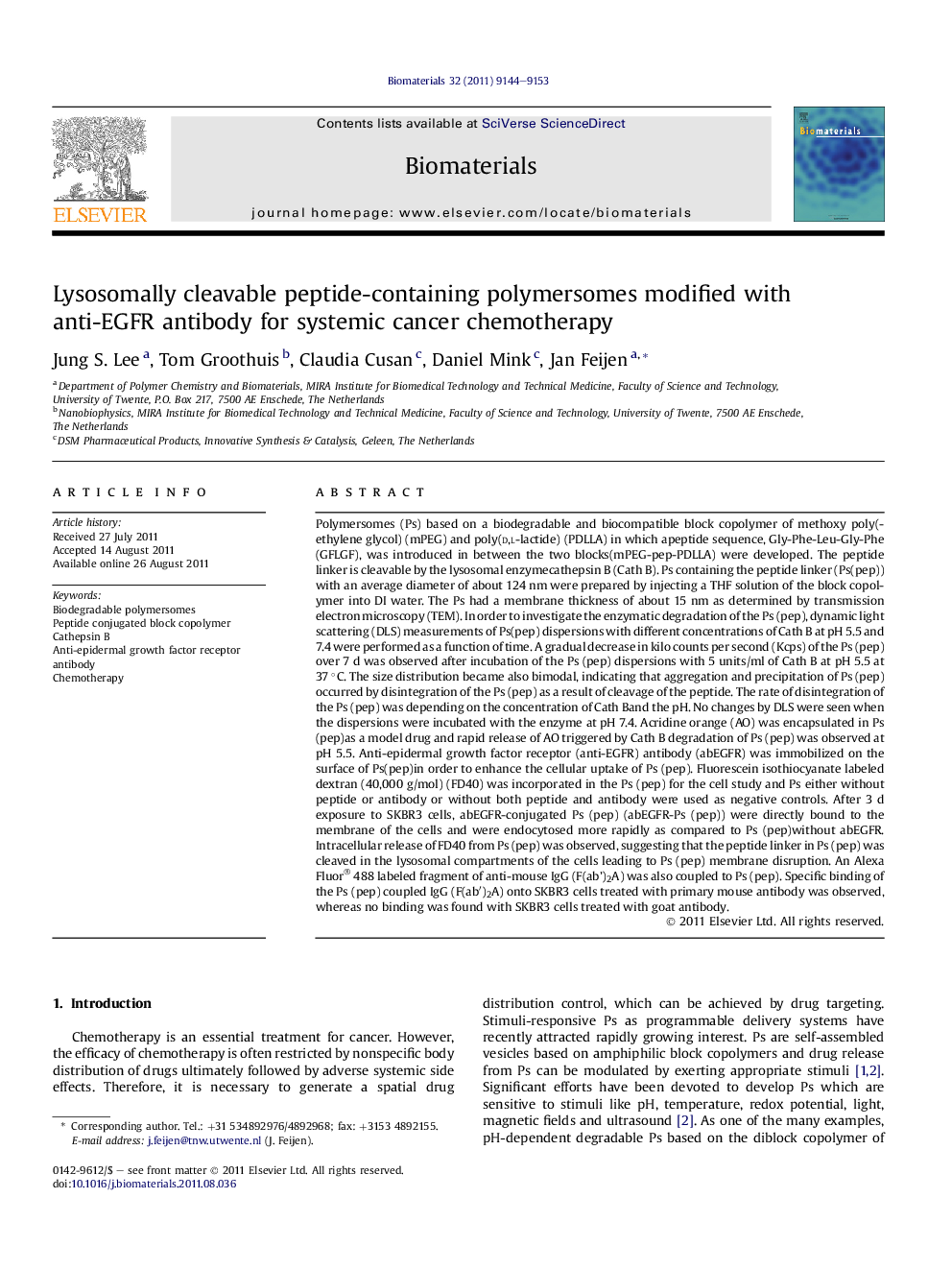| کد مقاله | کد نشریه | سال انتشار | مقاله انگلیسی | نسخه تمام متن |
|---|---|---|---|---|
| 7136 | 535 | 2011 | 10 صفحه PDF | دانلود رایگان |

Polymersomes (Ps) based on a biodegradable and biocompatible block copolymer of methoxy poly(ethylene glycol) (mPEG) and poly(d,l-lactide) (PDLLA) in which apeptide sequence, Gly-Phe-Leu-Gly-Phe (GFLGF), was introduced in between the two blocks(mPEG-pep-PDLLA) were developed. The peptide linker is cleavable by the lysosomal enzymecathepsin B (Cath B). Ps containing the peptide linker (Ps(pep)) with an average diameter of about 124 nm were prepared by injecting a THF solution of the block copolymer into DI water. The Ps had a membrane thickness of about 15 nm as determined by transmission electron microscopy (TEM). In order to investigate the enzymatic degradation of the Ps (pep), dynamic light scattering (DLS) measurements of Ps(pep) dispersions with different concentrations of Cath B at pH 5.5 and 7.4 were performed as a function of time. A gradual decrease in kilo counts per second (Kcps) of the Ps (pep) over 7 d was observed after incubation of the Ps (pep) dispersions with 5 units/ml of Cath B at pH 5.5 at 37 °C. The size distribution became also bimodal, indicating that aggregation and precipitation of Ps (pep) occurred by disintegration of the Ps (pep) as a result of cleavage of the peptide. The rate of disintegration of the Ps (pep) was depending on the concentration of Cath Band the pH. No changes by DLS were seen when the dispersions were incubated with the enzyme at pH 7.4. Acridine orange (AO) was encapsulated in Ps (pep)as a model drug and rapid release of AO triggered by Cath B degradation of Ps (pep) was observed at pH 5.5. Anti-epidermal growth factor receptor (anti-EGFR) antibody (abEGFR) was immobilized on the surface of Ps(pep)in order to enhance the cellular uptake of Ps (pep). Fluorescein isothiocyanate labeled dextran (40,000 g/mol) (FD40) was incorporated in the Ps (pep) for the cell study and Ps either without peptide or antibody or without both peptide and antibody were used as negative controls. After 3 d exposure to SKBR3 cells, abEGFR-conjugated Ps (pep) (abEGFR-Ps (pep)) were directly bound to the membrane of the cells and were endocytosed more rapidly as compared to Ps (pep)without abEGFR. Intracellular release of FD40 from Ps (pep) was observed, suggesting that the peptide linker in Ps (pep) was cleaved in the lysosomal compartments of the cells leading to Ps (pep) membrane disruption. An Alexa Fluor® 488 labeled fragment of anti-mouse IgG (F(ab’)2A) was also coupled to Ps (pep). Specific binding of the Ps (pep) coupled IgG (F(ab′)2A) onto SKBR3 cells treated with primary mouse antibody was observed, whereas no binding was found with SKBR3 cells treated with goat antibody.
Journal: Biomaterials - Volume 32, Issue 34, December 2011, Pages 9144–9153